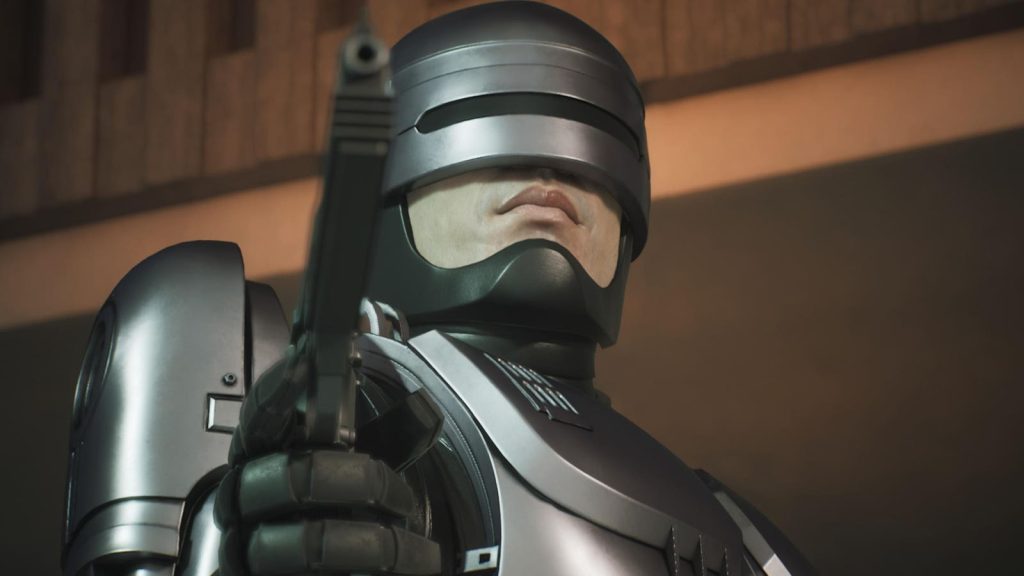Before talking about RoboCop: Rogue City–and while I’m sure this sentiment will be offered by other reviewers–I will not tell you if I will buy the game for a dollar, or multiple dollars. It is, however, remarkably surprising and entertaining, even if it tries to make you doubt it from the start.
There are some telltale moments early in RoboCop: Rogue City where you’d be forgiven for assuming it’ll be terrible. This starts as soon as Mediabreak TV reporter Casey Wong opens proceedings without really opening his mouth. Poor, off-timed lip synching, combined with his near-expressionless face, has you guessing which yellow or red score RoboCop 2023 will get on Metacritic, minutes before Metallic Murphy materializes on your monitor.
These concerns melt away when you finally become RoboCop, and you’re thrust into the news building to rescue any survivors from an inevitable gang insurgence. These overconfident goons become mere cannon fodder as Basil Poledouris’ original, iconic RoboCop theme kicks in and you mulch each one of them with your Auto-9, scoring extra damage for blowing their heads off, or–true to the source material–shooting them in the penis. My lord, it feels glorious.
In these first playable moments, RoboCop: Rogue City pushes any early worries you had to one side. Sure, it’s rough around the edges; its FPS mechanics aren’t anything special; it falls markedly short of the admittedly high bar set by triple-A games that conspire to make 2023 one of the finest years for gaming.
But RoboCop’s 2023 outing isn’t pretending to be premium–it’s trying to be fun, and it more than succeeds at this.
Robocop 2.5
Robocop: Rogue City is set between the events of RoboCop 2 and 3, and wouldn’t you know it, Old Detroit has been hit by another crime wave. Wendell “The New Guy” Antonowsky, a previously unknown threat, has established himself as a malevolent force at the center of a conspiracy, and it’s on you as Alex Murphy–voiced by OG RoboCop actor Peter Weller–to take him down.
It’s not an easy task, thanks to the re-emergence of repressed human memories that RoboCop experiences early in the game–ones caught on camera by Mediabreak, which sow doubt in Murphy’s ability to do his job. Max Becker, the OCP rep effectively in charge of Detroit’s police–and Rogue City’s designated dickhead–signs you up with a psychologist and tries to take you off duty. Tries.
This psychoanalysis from Dr Olivia Blanche underpins a wider, episodic narrative with side-quests, and plenty of gang violence–a dystopian, 80s version of The Sopranos, in some ways. This regular check-in session is crucial in the story’s development, not least because it makes Murphy a lot more human–much more so than underperforming graphics that undermine otherwise solid vocal performances from the rest of the cast. Really, there’s more emotion in RoboCop’s visible mouth than the rest of the game’s faces combined.
Slow and steady solves the case
RoboCop: Rogue City gives you tank status. You tower over other humans, and you’re understandably slow, even at the light jogging speed you reach in “sprint” mode. Despite your RoboCop vision, which highlights targets with green outlines, nothing feels precise, however hard you try to finesse your settings; lining up the perfect headshot takes both luck and skill. The wholesale lack of a cover system also makes you into a bullet sponge where you simply have to deal with taking damage and frequent healing.
However, this is a feature rather than a fault, because RoboCop: Rogue City papers over the cracks of cumbersome movement and aiming mechanics with the simple virtue that the protagonist is cumbersome himself. It does have its downsides–hostage-saving breaches in particular require perfect responses for success, and you’ll rarely leave one of these sections without at least some innocent brains on the carpet.
Levels are designed as self-contained, small-ish areas with enough going on–whether it’s packs of enemies, lootable items that help you level up and unlock new skills, or side quests–to mostly overcome the slower movement.
RoboCop: Rogue City’s skill tree helps you discover and develop new skills–dashing, codebreaking, shockwaves, slow motion, and more. It’s important to unlock two or three of these early on if you want to make the game less brutal in its earliest stages, because it has a habit of overwhelming you at a moment’s notice with new enemy types, impromptu boss battles, or a simple numbers game. You’re a one-man army, after all.
This thankfully works both ways. In standard difficulty, RoboCop: Rogue City puts you in excellent situations of attrition, where you use your ever-growing suite of abilities to snipe away at enemies as you conserve the little energy you have left, recharging to 20% health between gunfights. There’s no greater feeling of satisfaction than somehow clinging on through a side-quest drugs bust with no recharges left, only to get pitched against a dozen guys and a couple of specialists, but somehow defeat them and revel in the glory.
Auto-9 shines
While RoboCop: Rogue City has over 20 weapons to pick up and play with, it almost feels wrong to use anything other than your leg-stored Auto-9, to the point you assume anything you do pick up will be worse. That’s actually not the case; even standard Uzis and assault rifles pack more of a punch than your default handgun, which is a saving grace, as enemies often take a lot to put them down, especially if they’re armored.
Luckily, printed circuit boards become available for your Auto-9, presenting an opportunity to upgrade your abilities while also offering a surprisingly fun, BioShock-esque minigame hinging on routing currents with collectable enhancement switches.
You can upgrade your gun in five ways, being careful to avoid penalties, while also unlocking other bonuses like gore enhancement or no-reload autofeeders. Each PCB is different, giving you the opportunity to have different loadouts for distinct circumstances.
Ghosts in the machine
Glitch-effect moments are a core story arc in the game, but RoboCop: Rogue City has so many tech issues that need patching. Enemies killed at long distances often disappear; occasionally, some stand, with their arms outstretched, posing no danger; you’ll get the odd one stuck in a wall. Certain subtitles can linger on screen, while some conversations have such uneven sound levels that you wonder if the people you’re speaking to have blown an eardrum during the previous firefight.
Graphically, RoboCop is also all over the shop. Some scenes, especially establishing shots leading in and out of sections, look gorgeous for the most part, but are hampered by pop-in textures that can take two or three seconds to appear. On at least three occasions on my Series X playthrough, framerates dropped to single-digit numbers until the game was restarted at a checkpoint–not ideal, given the odd pacing between each save point.
Yet none of these issues make the experience truly problematic; they kind of add to its charm, and take you back to a time in the early 2010s when games like this were ten a penny, but the likes of RoboCop: Rogue City would’ve been GOTY material. That’s not to say it feels over ten years old; it just hasn’t innovated on that era’s formula for success.
A throwback delight
Part of the reason this review lands a day after the embargo lifted is simple–there’s so much more to RoboCop: Rogue City than you’d ever expect. You’re rewarded for exploration, whether it’s completing side missions with interesting, self-contained storylines–the sort Fallout games have down to a tee–and while the humor and satire presented by 1987’s RoboCop is in shorter supply than it could be, it still meets the expectations of fans and newcomers alike.
Will you enjoy every minute of RoboCop? Probably not. Will you still come away from it feeling satisfied? Most likely. RoboCop: Rogue City is the perfect example of That 7/10 Game–one you’ll forget about playing in a few months’ time, then randomly recall through a handful of vague memories of endless violence, drab-colored levels, and weird side quests–all underpinned by genuine feelings of happiness.
Aside from that first lobby scene, of course. That bit’ll live rent-free in your head for a long, long time.
Read the full article here










